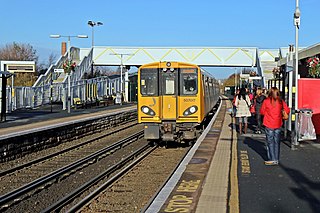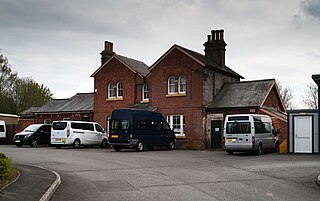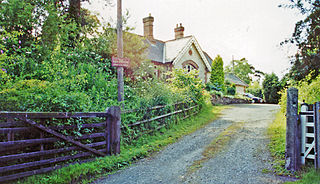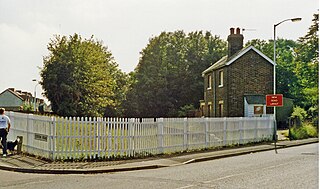Related Research Articles

Aintree railway station is a railway station that serves the village of Aintree, Merseyside, England. It is on the Ormskirk branch of the Merseyrail network's Northern Line. Until 1968 it was known as Aintree Sefton Arms after a nearby public house. The station's design reflects that it is the closest station to Aintree Racecourse, where the annual Grand National horse race takes place.

Gosport railway station was a terminus station designed by William Tite and opened to passenger and freight trains in 1841 by the London and South Western Railway (LSWR). It was closed in 1953 to passenger trains, and in 1969 to the remaining freight services. It is a Grade II* listed building.

There are eleven disused railway stations on the Exeter to Plymouth line between Exeter St Davids and Plymouth Millbay in Devon, England. At eight of these there are visible remains.

Selsdon railway station was at the junction of the Croydon, Oxted and East Grinstead Railway and the now-closed Woodside and South Croydon Joint Railway. Opened in 1885 as Selsdon Road, it was 2 miles (3.2 km) from Selsdon village.
Thackley railway station was a railway station in Thackley, West Yorkshire, England.

Kimberley West railway station was a station serving the town of Kimberley in Nottinghamshire, England.

Wilton South railway station is a disused railway station which served Wilton in Wiltshire, England, on the West of England line from London Waterloo to Exeter.
The Brill Tramway, also known as the Quainton Tramway, Wotton Tramway, Oxford & Aylesbury Tramroad and Metropolitan Railway Brill Branch, was a six-mile (10 km) rail line in the Aylesbury Vale, Buckinghamshire, England. It was privately built in 1871 by the 3rd Duke of Buckingham as a horse tram line to transport goods between his lands around Wotton House and the national railway network. Lobbying from residents of the nearby town of Brill led to the line's extension to Brill and conversion to passenger use in early 1872. Two locomotives were bought for the line, but as it had been designed and built with horses in mind, services were very slow; trains travelled at an average speed of only 4 miles per hour (6.4 km/h).
The Lee-on-the-Solent Line was a three mile long railway in Hampshire, England; it was built by the Lee-on-the-Solent Railway Company, promoted in association with a landowner's wish to develop a new seaside resort on his land.

Little Salkeld was a railway station which served the village of Little Salkeld in Hunsonby parish and Great Salkeld, Cumbria, England. The Settle-Carlisle Line remains operational for freight and passenger traffic. The station was built by the Midland Railway and opened in 1876. It closed in 1970, when the local stopping service over the line was withdrawn by British Rail.
New Biggin or Newbiggin was a railway station which served the village of Newbiggin near Kirkby Thore in Newbiggin parish, Cumbria, England. It was located on the Settle-Carlisle Line, 24+3⁄4 miles (39.8 km) south of Carlisle. Whilst the station is now disused, the line is still operational and the nearest open station is Appleby.
Mickle Trafford East railway station was located in Mickle Trafford, Cheshire, England. The station was opened by the Cheshire Lines Committee on 1 May 1875, closed to passengers on 12 February 1951 and closed completely on 1 July 1963 by the British Railways Board It was located where the CLC route to Chester Northgate passed close to the Birkenhead Joint Railway line from Warrington Bank Quay - the latter also had its own station nearby, opened in 1889 and closed just a couple of months after Mickle Trafford East.

Hepscott railway station served the village of Hepscott, Northumberland, England, from 1858 to 1964 on the Blyth and Tyne Railway.
Willington railway station served the town of Willington, County Durham, North East England from 1857 to 1964 on the Durham to Bishop Auckland Line.

Fort Brockhurst railway station served the town of Gosport, Hampshire, England from 1865 to 1953 on the Fareham-Gosport line.

Durham (Gilesgate) railway station served the Gilesgate area of Durham City in County Durham, North East England from 1844 to 1857 as the terminus of the Newcastle & Darlington Junction Railway Durham Branch passenger service. Its life as a passenger station was short and it was quickly converted to goods station, a role which it played for more than a century.
Elmore Halt railway station served the suburbs of Lee-on-Solent, Hampshire, England from 1910 to 1930 on the Lee-on-the-Solent Railway.
Fort Gomer Halt railway station served the town of Gosport, Hampshire, England from 1894 to 1930 on the Lee-on-the-Solent Railway.
Browndown Halt railway station served the town of Gosport, Hampshire, England from 1894 to 1930 on the Lee-on-the-Solent Railway.

Tow Law railway station served the town of Tow Law, County Durham, England, from 1847 to 1965 on the Stanhope and Tyne Railway.
References
- ↑ Quick, M E (2002). Railway passenger stations in England, Scotland and Wales - a chronology. Richmond: Railway and Canal Historical Society. p. 260. OCLC 931112387.
- ↑ "Disused Stations: Lee-on-the-Solent Station". Disused Stations. Retrieved 11 April 2018.